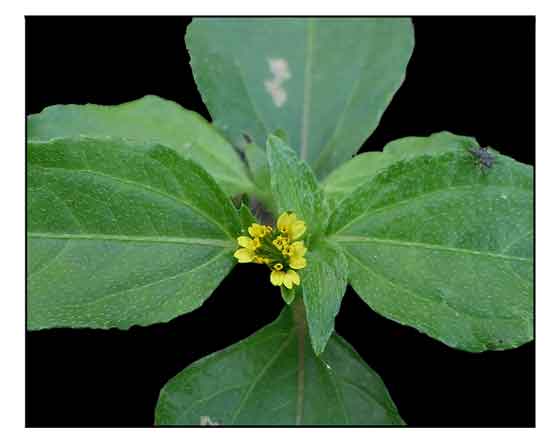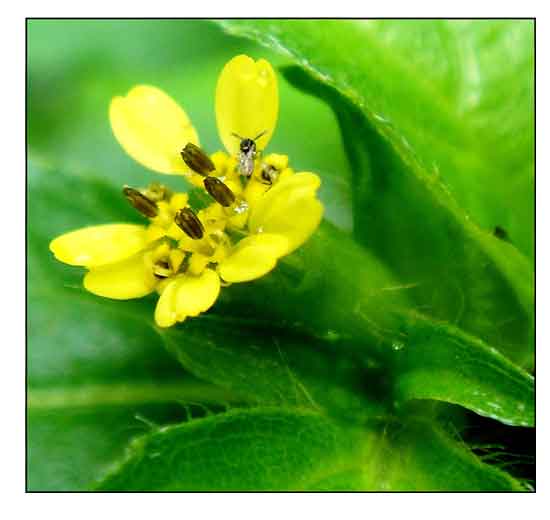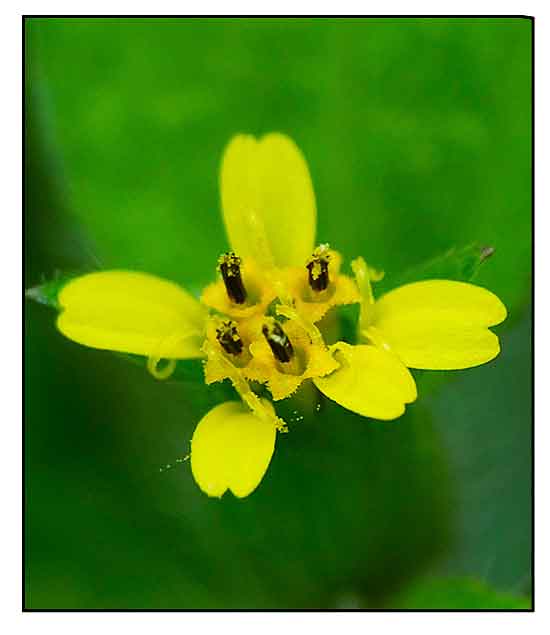Gen info
- Synedrella is a genus of flowering plants in the family Asteraceae.
- It contains only one species, Synedrella nodiflora, native to South America, Central America, Mexico, the West Indies, and Florida. It is naturalized in much of Asia, northern Australia, some Pacific Islands, and tropical Africa.
(25)
 Botany Botany
Synedrella nodiflora is an an annual herb, 25-90 cm tall, with a tough erect, subangular stem, sometimes prostrate and rooting at the nodes, repeatedly forked, appressed pilose. Leaves opposite, simple, elliptical to ovate, 1.5-12.5 cm × 0.5-9 cm, base cuneate, suddenly narrowed into the petiole and decurrent along it, apex acute, margins crenate-serrate, more or less hispidulous on both surfaces, distinctly triveined; petiole 0.5-5.5 cm long, the 2 opposite petioles connected by a small rim; stipules absent. Inflorescence an axillary or terminal head; involucral bracts 4-5, 2-seriate, narrowly oblong, outer ones about 9 mm long, acute, thinly white-hairy, finely glandular, pale green, inner ones about 7 mm long, subobtuse, glabrous, bracts clasping the flowers; peduncle absent or up to 4.5 cm long; heads 1(-7) per axil, 10-20-flowered, cylindrical when young, afterward campanulate, about 4 mm across. Ligulate flowers 3-8, accrescent during anthesis, about 4.5 mm long, very obtusely toothed, yellow; tubular flowers 6-10, 4 mm long, 4-5-lobed, yellow; anthers 4, connate, with an entire base and an obtuse top, blackish-brown; style-arms 2, long, pubescent, with acute, glabrous tips. Fruit an achene, of ligulate flowers oblong, 4-5.5 mm × 3 mm, dorsally flattened with a broad wing along the margins, with 5-9 acute erect-patent lobes, and 2 apical bristles, 2-2.5 mm long, the wings first black, later yellow, glabrous; achene of tubular flowers slender, narrowly wedge-shaped, 4-5 mm long, ribbed, often warty, with 2-3 bristles, 3-5 mm long, glabrous or with short hairs, black or dark-brown; pappus absent. Seedling with epigeal germination; hypocotyl up to 2 cm long, purplish red; cotyledons 2, petiole 1-2 cm long, blade elliptical to ovate, up to 7 mm long, glabrous, midvein distinct; epicotyl short, densely appressed hairy; first leaves opposite, subsessile, ovate, up to 10 mm long, margins shallowly toothed, sparsely hairy. (2)
Distribution
- Introduced.
-
Native range is Tropical and Subtropical America, growing primarily in seasonally dry tropical biome. (1)
 Constituents Constituents
- Steam distillation of the leaves yields a yellow colored essential oil (0.02%), with the terpenes β-caryophyllene,β-farnesene, germacrene-D and β-cubebene as major components. Ethanol extract of the whole plant yielded the triterpenoid saponin nodifloside A (oleanolic acid-3-O-β-D-xylopyranosyl-(1 forward 4)-β-D-glucopyranuronosyl methylate), together with the triterpenoid oleanic acid-3-O-β-D-glucopyranuronosyl methylate, and the steroidsβ-sitosterol, stigmasterol, stigmasterol-3-O-β-D-glycoside and rosasterol. S. nodiflora also contains a high content of estradiol. (2)
- Methanol extract of aerial parts yielded
a relative abundance and concentration of flavonol, alkaloid, flavanol, phenolics, tannin, proanthocyanidins and saponin with relative abundance (%) of the phytochemicals is in the order of polyphenols (19.09) > Saponin (18.61) > flavonol (18.00) > proanthocyanidins (14.52) > flavanol (10.35) > Alkaloid (10.07) > tannins (9.36). (see study below) (3)
- Stem distillation of S. nodiflora leaves yielded 0.02% yellow oil. Capillary gas-liquid chromatography showed the oil to be rich in aliphatic alcohols, monoterpenes, sesquiterpene hydrocarbons and oxygenated sesquiterpenes, with major components of ß-caryophyllene, ß-farnesene, germacrene-D, and ß cubebene. (12)
- Phytochemical screening of leaves yielded alkaloids, saponins, steroids, tannins, with absence of glycosides. (13)
- Phytochemical screening of crude hydro-ethanolic extract yielded phenols, flavonoids, tannins, glycosides, sterols, terpenoids, and alkaloids. (see study below) (19)
- Study of methanolic extract yielded
total phenols and total antioxidant capacity of 37.38 mg/g equivalent of gallic acid and 433.37 mg/gm equivalent of ascorbic acid. (see study below) (27)
Properties
- Studies have suggest antioxidant, tyrosinase and elastase inhibiting, anticonvulsant, anti-inflammatory, anti-psychotic, antimalarial, insecticidal, analgesic, clastogenic, cytotoxic, hepatoprotective, hypoglycemic, antidiarrheal, immunosuppressive, CNS depressant properties.
Parts used
Roots, leaves, sap.
 Uses Uses
Edibility
- In Indonesia, tender leaves used in salads. (2)
Folkloric
- In Zamboanga del Sur, poultice of whole plant applied on wounds. (21)
-
In tropical America, Asia, and Africa, used for treatment of liver disease, asthma, rheumatism, earache.
-
In Indonesia, poultice of leaves applied to sore legs and rheumatism; leaf juice used for earache. In Africa, embrocation of leaves used for various edemas; juice leaf used for treatment of infected gums. In Ghana, infusion of young leaves used as laxative. In Papua New Guinea, roots chewed to treat diarrhea; sap from squeezed leaves massaged daily on dislocated bones. In Fiji, leaf decoction used to treat diarrhea and hemorrhoids. In Africa and the Barbados, decoction of pounded and cooked roots drunk as a cough mixture. In Columbia, plant used as emmenagogue. (2)
- In Ghana, traditionally used for treatment of epilepsy.
- In Malaysia, used for treatment of rheumatism.
- In Bangladesh, leaf juice taken orally for stomach ache. (23)
Others
- Fodder: In Indonesia, plant eaten by horses, cattle, pigs, and rabbits. (2)
Studies
• Antioxidant / Skin Enzyme Inhibiting / Aerial Parts: Study evaluated a methanol extract of aerial parts for antioxidant capacity, inhibitory activity against skin degenerating enzymes of elastase and tyrosinase and anti-lipid peroxidation activity. The extract showed ability to scavenge free radicals and inhibit degradation of lipids due to oxidative damage. Extract also exhibited mild invitro tyrosinase and elastase inhibiting activity, which suggest potential for cosmetic application in skin depigmentation and anti-wrinkle pharmaceutical formulations (see constituents above) (3)
• Use in Animal Husbandry / Improvement in Reproductive Parameters / Leaves: Overall, S. nodiflora contains a high content of estradiol. From the plant's sex hormone activity, study suggests Synedrella nodiflora leaves can be used as Pregnant Mare Serum Gonadotrophin supplier in animal husbandry to improve reproductive parameters in females. (4)
• Toxicity Concerns: A 14-day oral use of whole plant extract (100, 300, and 1000 mg/kg) in rats produced no mortality with no significant effect on hematological and biochemical indices and no abnormal post-mortem findings. Study suggests safety at therapeutic doses of 100, 300, and 1000 mg/kg. However, some authors have reported aqueous extract of leaves caused toxic or cellular degeneration of seminiferous tubules in wistar rats at dose 100 mg/rat. (4)
• Impact on Reproductive Performance in Rabbits / Leaves: Study evaluated the effect of Synedrella nodiflora leaves as food supplement in the diet of rabbits on reproductive performance of rabbits. Results suggest the use of leaves as feed supplement in rabbits improves fertility rate and litter size, and significantly reduces mortality rate from birth to weaning. (5)
• Antipsychotic / Leaves: Study evaluated the antipsychotic potential of S. nodiflora extract (SNE) in several murine models of psychosis. Novelty-induced rearing, locomotion and steriotypy counts provoked by SNE (100-1000 mg/kg p.o.) were conducted using open-field paradigm. SNE showed acetylcholine-like and serotonin-like activities and significantly reduced frequencies of novelty- and apomorphine-induced rearing and locomotion; stereotypy behavior and frequency and duration of apomorphine-induced cage climbing in mice. SNE was less potent than reference drugs chlorpromazine and haloperidol. SNE exhibited antipsychotic properties by itself, but also potentiated the antipsychotic effects of chlorpromazine and haloperidol. (6)
• Anti-Inflammatory / Regulation of Syk in RAW 264.7 Macrophages / Leaves: Study evaluated the anti-inflammatory mechanism of methanol extract o S. nodiflora (MSN) in RAW 264.7 macrophages activated by lipopolysaccharide (LPS). Results showed decreased expression of iNOS and COX-2, which resulted in decrease in nitric oxide and PGE2 production. The mRNA expression of pro-inflammatory cytokines such as IL-6, IL-1ß, and TNF-α was reduced, along with suppression of activation of spleen tyrosine kinase (Syk) and Akt. Results suggest the potential of MSN as a novel therapeutic agent for inflammation-related diseases. (7)
• Anticonvulsant / Neuropharmacological Effects / Whole Plant: Study evaluated the anticonvulsant and other neuropharmacological effects of hydroalcoholic extract of whole plant using murine models. Anticonvulsant effect was evaluated on pentyenetetrazole-, picrotoxin, and pilocarpine-induced seizure models and PTZ-kindling in mice and rats. Extract was also tested on motor coordination using rota-rod. Results showed antioxidant effects, possibly through interaction with GABAergic transmission, antioxidant mechanisms, and muscle relaxant effects. Results suggest potential use in the management of epilepsy. (8)
• Anti-Seizure / Depression of Excitatory Synaptic Transmission in Rat Hippocampus: Study evaluated the neuronal basis of the plant's effect in suppressing seizure activity using hippocampal slice preparation from rats. Bath perfusion of the hydroalcoholic extract cause a concentration-dependent depression of evoked field excitatory postsynaptic potentials (fEPSPs) accompanied by increase in paired pulse facilitation. Results showed the SNE depresses fEPSPs and spontaneous bursting activity in hippocampal neurons that may underlie its ability to abort convulsive activity in persons with epilepsy. (9)
• Antibacterial / Antioxidant: Study evaluated hexane, ethyl acetate, ethanol, and water extracts of
S. nodiflora for antibacterial activity by disc diffusion, MIC, MBC, and death kinetic assays against six bacterial strains and antioxidant capacities by FRAP and ß-carotene bleaching assays. The ethanol extract showed activity against all bacteria tested and exhibited significant antioxidant activities in both FRAP and ß-carotene bleaching assays. Spectrometry assays indicated presence of phenolic compounds, including flavonoids, in the ethanol extract (10)
• Antimalarial / Leaves: Study evaluated the antimalarial and toxicity of leaf extract of Synedrella nodiflora in mice intraperitoneally injected with Plasmodium bergheii ANKA strain and administered extract daily for 4 days. Results showed SN crude extract at dose of 600, 400, and 200 mg/kbw significantly suppressed parasitemmia in malaria infected mice by 62.65%, 57.67% and 38.57%, respectively. No symptoms of acute toxicity were observed, no significant alterations of biochemical parameters of liver and kidney function, and no histological changes in the liver and kidney. (11)
• Insecticidal / Anti-Inflammatory / Leaves: Study evaluated a methanolic extract of leaves for insecticidal and anti-inflammatory potential against insect Sitophilus oryzae using surface film method and carrageenan and formalin induced paw edema in rat. Insecticidal activity at doses of 50, 100, and 200 mg/kbw showed dose-dependent insecticidal activity at 95%, 96%, and 98% respectively. Significant inhibition of paw edema was seen in both models, with 50% inhibition at 200 mg/kbw, almost similar to standard anti-inflammatory drug, indomethacin. (14)
• Analgesic Effects / Paclitaxel-Induced Neuropathic Pain / Whole Plant: Study evaluated analgesic effects of hydro-alcoholic extract of whole plant a rat model of paclitxel-induced neuropathic pain. Two days after induction of neuropathy, the extract (100, 300, and 1000 mg/kg p.o.) and pregabalin (10, 30, and 100 mg/kg) significantly and dose-dependently produced antinociceptive effect. (15)
• Long-Term Toxicological Study: There have been conflicting reports on S. nodiflora toxicity. Study evaluated the effect of 90-day continuous oral administration of hydro-alcoholic whole plant extract of S. nodiflora in male Sprague-Dawley rats using doses of 100, 300, and 1000 mg/kg and focusing on hematological, serum biochemical parameters and histopathological changes of some isolated organs.
Results showed no mortality during the study period. Doses of 300 and 1000 mg/kg had no significant effect on hematological and biochemical parameters measured. Only the 1000 mg/kg dose of SNE produced distortions of branching arrangements of myocardial fibers and a congested vessel that indicated a healed infarction. Results suggest a low toxicity profile following a 90-day continuous oral trial under present laboratory conditions. However, patients with renal or cardiac problems should use the plant with caution. (16)
• Clastogenic / Cytotoxic / Aerial Parts: Study evaluated the clastogenic and cytotoxic effects of aqueous extract of aerial parts on Wistar rat bone marrow cells. Data showed dose-dependent increase in aberrant cell frequencies, chromosomal structural aberrations and significant (p<0.001) increase in apoptosis in extract treated WRBMCs. Results suggest the extract may contain phytochemicals with both clastogenic and cytotoxic effects of wistar rat bone marrow cells, indicating anticancer as well as carcinogenic potentials. Further studies should explore active principle(s) and proper care taken in using it in traditional medicine. (17)
• Antiucler Potential / Toxicity Study / Leaves: Study evaluated the antiulcer effects of crude leaf extract of Synedrella combined with honey in rat models induced by absolute ethanol and pyloric ligation. Acute toxicity study showed no death in mice at 5000 mg/kg (LD50 > 5000 mg/kg). Results showed a 100 mg/kg dose of crude extract and 1cc of honey had 42.9% and 71.76% inhibition of ulceration, respectively, while the same dosage in combination with hone had 74.65% inhibition of ulceration. Results showed the combination of methanol leaf extract and honey exhibited gastro-protective effect and reduced gastric acid in rats and suggest a potential in the treatment of ulcers. (18)
• Antiproliferative / MCF-7 and Jurkat Cell Lines / Antioxidant: Study evaluated crude hydro-alcoholic extract and fractions of S. nodiflora for antioxidant and in vitro inhibition of cancer cell lines. Extract scavenged DPPH with IC50 of 114 µg/ml, while the EA fraction showed IC50 of 8.9 µg/ml. EAF produced anti-proliferative effects against MCF-7 (human breast cancer) and Jurkat (leukemic) cells lines with IC50s of 205.2 and 170.9 µg/ml, respectively. Results showed the EAF exhibited the most potent antioxidant activity, inhibited proliferation of breast and leukemic cancer cell lines, while having weak cytotoxic effect on normal liver cells. (19)
• Antinociceptive / Whole Plant: Study evaluated the antinociceptive effect of ethanolic extract of whole plant using formalin-induced pain and acetic acid induced writhing assay and possible mode(s) of action of its analgesic action. Morphine and diclofenac were used as standard opioid and NSAID respectively, The ethanolic extract (100-1000 mg/kg p.o.) and morphine (1-10 mg/kg i.p.) dose-dependently decreased both phases of formalin-induced nociceptive behavior. In acetic-acid induced writhing test, diclofenac and S. nodiflora significantly reduced the number of writhes dose dependently. The effect of S. nodiflora was blocked by caffeine while the analgesic effect of diclofenac was enhanced significantly. The observed effects on central and peripheral analgesic effects suggest the possible involvement of adenosinergic mechanism(s). (20)
• Hepatoprotective / Carbon Tetrachloride Toxicity / Immunosuppressive / Leaves: Study evaluated the hepatoprotective effect of crude aqueous extract of S. nodiflora leaves against carbon tetrachloride (CCl4)-mediated hepatic injury in Sprague-Dawley rats. Biochemical, immuno-histochemical, histological, and ultrastructural findings support the hepatoprotective effect of S. nodiflora against CCl4-mediated oxidative hepatic damage. The hepatoprotectiive effects may be attributed to the presence of phenolic antioxidants and free radical scavenging property. (22)
• Antiproliferative / Aerial Parts: Study evaluated the antiproliferative activity of aqueous extract of S. nodiflora in root and shoot apical meristems and WRBMCs (Wistar rat bone marrow cells). Phytotoxic and antiproliferative activities of AESN were evaluated using green-gram seedlings and onion roots. AESN treatment showed dose dependent root and shoot growth retardation and reduced number of branch root sprouting in green-gram seedlings. In WRBMCs, AESN treatment could induced significant (p<0.001) mitodepression. Results suggest AESN contains antiproliferative active principle(s) that can induce significant delay in cell cycle kinetics in apical meristems and WRBMCs. (24)
• Antidiarrheal / Hypoglycemic / Leaves: Study evaluated the antidiarrheal and hypoglycemic potential of methanol extract of S. nodiflora leaves in mice. In castor oil-induced diarrheal model, extract doses of 200 and 400 mg/kbw showed 58.97% and 73.91% inhibition after 4 hr. In hypoglycemic testing, an intraperitoneal extract administration of 150 and 300 mg/kbw showed glucose level reduction of 57.87% and 66.83% in alloxan induced rat compared to 7% with metformin after 3 days. Results suggest antidiarrheal and hypoglycemic potential of S. nodiflora. (26)
• Antioxidant / Analgesic / CNS Depressant: Study evaluated the antioxidant, analgesic, and CNS depressant effects of methanolic extract of S. nodiflora. Percentage scavenging of DPPH free radicals was concentration dependent with IC50125.89 µg/ml compared to standard ascorbic acid at 16.76 µg/ml. Reducing power was concentration dependent. SN significantly (p<0.001) inhibited writhing response induced by acetic acid with 40.06% and 61.83% at doses of 100 and 200 mg/kbw, and 56.96% and 62.60% inhibition of itching response induced by formalin. The ME at 250 and 500 mg/kbw significantly (p<0.001) decreased locomotion. Results suggest a potential natural source of a natural antioxidant with analgesic and CNS activity. (27)
• Thrombolytic Activity / Hemolysis Inhibition / Whole Plant: Study evaluated various extract of S. nodiflora for thrombolytic activity. Chloroform soluble fraction showed highest thrombolytic activity with 46.37% clot lysis. Petroleum ether and methanol soluble fractions exhibited 60.24% and 55.42% inhibition of hemolysis of RBC induced by hypotonic solution, respectively. (28)
• Antiarthritic Activity: Study evaluated chloroform and ethanolic extracts of Synedrella nodiflora for antiarthritic activity using protein denaturation assay. Protein denaturation assay is based on the effect of the plant extract in inhibiting the denaturation protein from heat. Increasing concentrations exhibited different percentage inhibition. Results showed antiarthritic activity. The ethanolic extract was equally effective when compared to standard drug diclofenac sodium. Activity was attributed, partly, to phenolic constituents of the plant. (29)
Availability
Wild-crafted.
|

![]()




 Constituents
Constituents
